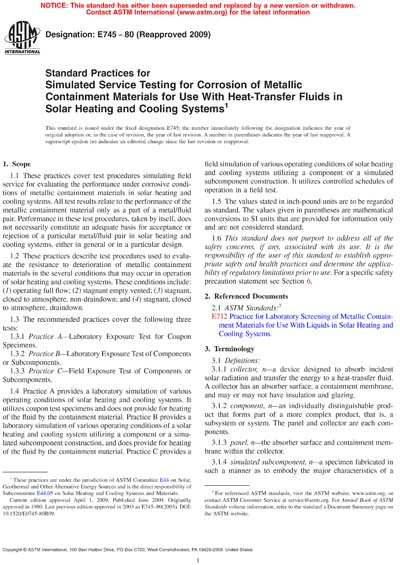Historical
ASTM E745-80(2009)
Standard Practices for Simulated Service Testing for Corrosion of Metallic Containment Materials for Use With Heat-Transfer Fluids in Solar Heating and Cooling Systems
1.1 These practices cover test procedures simulating field service for evaluating the performance under corrosive conditions of metallic containment materials in solar heating and cooling systems. All test results relate to the performance of the metallic containment material only as a part of a metal/fluid pair. Performance in these test procedures, taken by itself, does not necessarily constitute an adequate basis for acceptance or rejection of a particular metal/fluid pair in solar heating and cooling systems, either in general or in a particular design.
1.2 These practices describe test procedures used to evaluate the resistance to deterioration of metallic containment materials in the several conditions that may occur in operation of solar heating and cooling systems. These conditions include: (1) operating full flow; (2) stagnant empty vented; (3) stagnant, closed to atmosphere, non-draindown; and (4) stagnant, closed to atmosphere, draindown.
1.3 The recommended practices cover the following three tests:
1.3.1 Practice A—Laboratory Exposure Test for Coupon Specimens.
1.3.2 Practice B—Laboratory Exposure Test of Components or Subcomponents.
1.3.3 Practice C—Field Exposure Test of Components or Subcomponents.
1.4 Practice A provides a laboratory simulation of various operating conditions of solar heating and cooling systems. It utilizes coupon test specimens and does not provide for heating of the fluid by the containment material. Practice B provides a laboratory simulation of various operating conditions of a solar heating and cooling system utilizing a component or a simulated subcomponent construction, and does provide for heating of the fluid by the containment material. Practice C provides a field simulation of various operating conditions of solar heating and cooling systems utilizing a component or a simulated subcomponent construction. It utilizes controlled schedules of operation in a field test.
1.5 The values stated in inch-pound units are to be regarded as standard. The values given in parentheses are mathematical conversions to SI units that are provided for information only and are not considered standard.
1.6 This standard does not purport to address all of the safety concerns, if any, associated with its use. It is the responsibility of the user of this standard to establish appropriate safety and health practices and determine the applicability of regulatory limitations prior to use. For a specific safety precaution statement see Section 6.
Content Provider
ASTM International [astm]






